File Info
| Exam | Querying Data with Transact-SQL |
| Number | 70-761 |
| File Name | Microsoft.70-761.ActualTests.2019-03-27.115q.vcex |
| Size | 14 MB |
| Posted | Mar 27, 2019 |
| Download | Microsoft.70-761.ActualTests.2019-03-27.115q.vcex |
How to open VCEX & EXAM Files?
Files with VCEX & EXAM extensions can be opened by ProfExam Simulator.
Coupon: MASTEREXAM
With discount: 20%





Demo Questions
Question 1


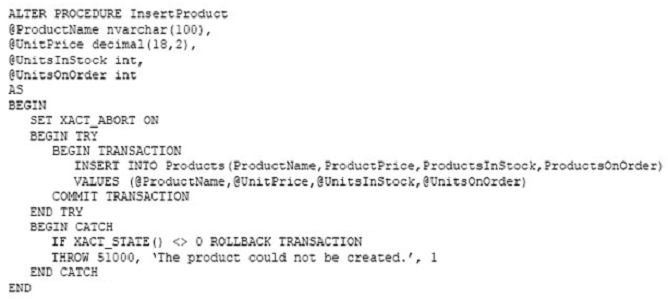
Note: This question is part of a series of questions that present the same scenario. Each question in the series contains a unique solution that might meet the stated goals. Some question sets might have more than one correct solution, while others might not have a correct solution.
After you answer a question in this section. You will NOT be able to return to it. As a result, these questions will not appear in the review screen.
You create a table named Products by running the following Transact-SQL statement:

You have the following stored procedure:

You need to modify the stored procedure to meet the following new requirements:
- Insert product records as a single unit of work.
- Return error number 51000 when a product fails to insert into the database.
- If a product record insert operation fails, the product information must not be permanently written to the database.
Solution: You run the following Transact-SQL statement:

Does the solution meet the goal?
- Yes
- No
Correct answer: B
Explanation:
With X_ABORT ON the INSERT INTO statement and the transaction will be rolled back when an error is raised, it would then not be possible to ROLLBACK it again in the IF XACT_STATE() <> O ROLLBACK TRANSACTION statement. Note: A transaction is correctly defined for the INSERT INTO ..VALUES statement, and if there is an error in the transaction it will be caughtant he transaction will be rolled back, finally an error 51000 will be raised.Note: When SET XACT_ABORT is ON, if a Transact-SQL statement raises a run-time error, the entire transaction is terminated and rolled back.XACT_STATE is a scalar function thatreports the user transaction state of a current running request. XACT_STATE indicates whether the request has an active user transaction, and whether the transaction is capable of being committed. The states of XACT_STATE are:0 There is no active user transaction for the current request. 1 The current request has an active user transaction. The request can perform any actions, including writing data and committing the transaction. 2 The current request has an active user transaction, but an error hasoccurred that has caused the transaction to be classified as an uncommittable transaction. References:https://msdn.microsoft.com/en-us/library/ms188792.aspxhttps://msdn.microsoft.com/en-us/library/ms189797.aspx With X_ABORT ON the INSERT INTO statement and the transaction will be rolled back when an error is raised, it would then not be possible to ROLLBACK it again in the IF XACT_STATE() <> O ROLLBACK TRANSACTION statement.
Note: A transaction is correctly defined for the INSERT INTO ..VALUES statement, and if there is an error in the transaction it will be caughtant he transaction will be rolled back, finally an error 51000 will be raised.
Note: When SET XACT_ABORT is ON, if a Transact-SQL statement raises a run-time error, the entire transaction is terminated and rolled back.
XACT_STATE is a scalar function thatreports the user transaction state of a current running request. XACT_STATE indicates whether the request has an active user transaction, and whether the transaction is capable of being committed.
The states of XACT_STATE are:
- 0 There is no active user transaction for the current request.
- 1 The current request has an active user transaction. The request can perform any actions, including writing data and committing the transaction.
- 2 The current request has an active user transaction, but an error hasoccurred that has caused the transaction to be classified as an uncommittable transaction.
References:
https://msdn.microsoft.com/en-us/library/ms188792.aspx
https://msdn.microsoft.com/en-us/library/ms189797.aspx
Question 2



Note: This question is part of a series of questions that present the same scenario. Each question in the series contains a unique solution that might meet the stated goals. Some question sets might have more than one correct solution, while others might not have a correct solution.
After you answer a question in this section. You will NOT be able to return to it. As a result, these questions will not appear in the review screen.
You create a table named Products by running the following Transact-SQL statement:

You have the following stored procedure:

You need to modify the stored procedure to meet the following new requirements:
- Insert product records as a single unit of work.
- Return error number 51000 when a product fails to insert into the database.
- If a product record insert operation fails, the product information must not be permanently written to the database.
Solution: You run the following Transact-SQL statement:

Does the solution meet the goal?
- Yes
- No
Correct answer: B
Explanation:
A transaction is correctly defined for the INSERT INTO .VALUES statement, and if there is an error in the transaction it will be caught ant he transaction will be rolled back. However, error number 51000 will not be returned, as it is only used in an IF @ERROR = 51000 statement. Note: @@TRANCOUNT returns the number of BEGIN TRANSACTION statements that have occurred on the current connection.References:https://msdn.microsoft.com/en-us/library/ms187967.aspx A transaction is correctly defined for the INSERT INTO .VALUES statement, and if there is an error in the transaction it will be caught ant he transaction will be rolled back. However, error number 51000 will not be returned, as it is only used in an IF @ERROR = 51000 statement.
Note: @@TRANCOUNT returns the number of BEGIN TRANSACTION statements that have occurred on the current connection.
References:
https://msdn.microsoft.com/en-us/library/ms187967.aspx
Question 3
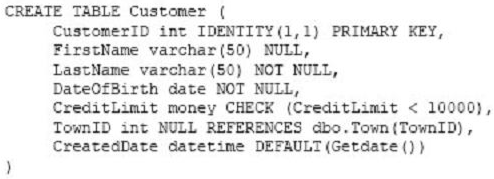


Note: This question is part of a series of questions that present the same scenario. Each question in the series contains a unique solution that might meet the stated goals. Some question sets might have more than one correct solution, while others might not have a correct solution.
After you answer a question in this section. You will NOT be able to return to it. As a result, these questions will not appear in the review screen.
You create a table named Customer by running the following Transact-SQL statement:

You must insert the following data into the Customer table:

You need to ensure that both records are inserted or neither record is inserted.
Solution: You run the following Transact-SQL statement:

Does the solution meet the goal?
- Yes
- No
Correct answer: B
Explanation:
As there are two separate INSERT INTO statements we cannot ensure that both or neither records are inserted. As there are two separate INSERT INTO statements we cannot ensure that both or neither records are inserted.
Question 4
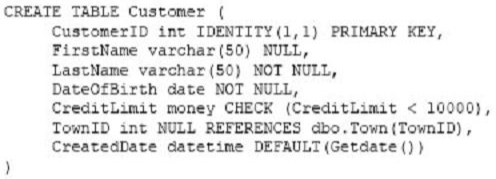


Note: This question is part of a series of questions that present the same scenario. Each question in the series contains a unique solution that might meet the stated goals. Some question sets might have more than one correct solution, while others might not have a correct solution.
After you answer a question in this section. You will NOT be able to return to it. As a result, these questions will not appear in the review screen.
You create a table named Customer by running the following Transact-SQL statement:

You must insert the following data into the Customer table:

You need to ensure that both records are inserted or neither record is inserted.
Solution: You run the following Transact-SQL statement:

Does the solution meet the goal?
- Yes
- No
Correct answer: B
Explanation:
As there are two separate INSERT INTO statements we cannot ensure that both or neither records are inserted. As there are two separate INSERT INTO statements we cannot ensure that both or neither records are inserted.
Question 5
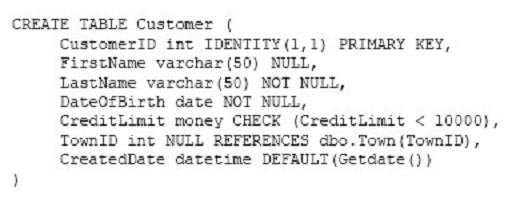


Note: This question is part of a series of questions that present the same scenario. Each question in the series contains a unique solution that might meet the stated goals. Some question sets might have more than one correct solution, while others might not have a correct solution.
After you answer a question in this section. You will NOT be able to return to it. As a result, these questions will not appear in the review screen.
You create a table named Customer by running the following Transact-SQL statement:

You must insert the following data into the Customer table:

You need to ensure that both records are inserted or neither record is inserted.
Solution: You run the following Transact-SQL statement:

Does the solution meet the goal?
- Yes
- No
Correct answer: A
Explanation:
With the INSERT INTO..VALUES statement we can insert both values with just one statement. This ensures that both records or neither is inserted. References:https://msdn.microsoft.com/en-us/library/ms174335.aspx With the INSERT INTO..VALUES statement we can insert both values with just one statement. This ensures that both records or neither is inserted.
References:https://msdn.microsoft.com/en-us/library/ms174335.aspx
Question 6
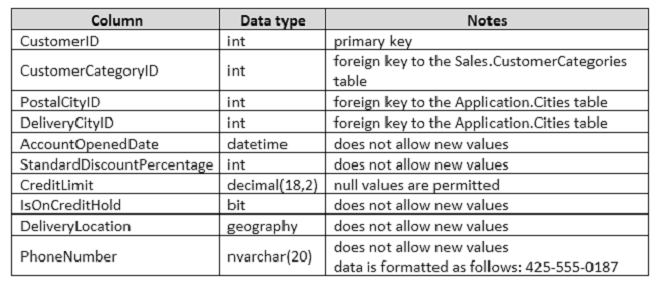


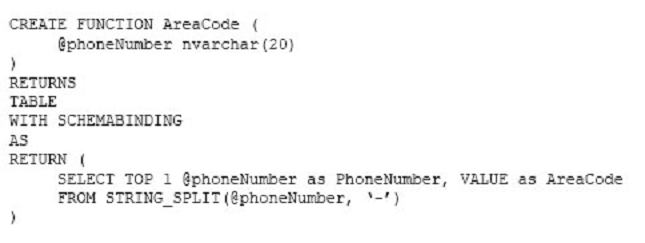
Note: This question is part of a series of questions that present the same scenario. Each question in the series contains a unique solution that might meet the stated goals. Some question sets might have more than one correct solution, while others might not have a correct solution.
After you answer a question in this section. You will NOT be able to return to it. As a result, these questions will not appear in the review screen.
You have a database that tracks orders and deliveries for customers in North America. The database contains the following tables:
Sales.Customers

Application.Cities

Sales.CustomerCategories

The company’s development team is designing a customer directory application. The application must list customers by the area code of their phone number. The area code is defined as the first three characters of the phone number.
The main page of the application will be based on an indexed view that contains the area and phone number for all customers.
You need to return the area code from the PhoneNumber field.
Solution: You run the following Transact-SQL statement:

Does the solution meet the goal?
- Yes
- No
Correct answer: B
Explanation:
The function should return nvarchar(10) and not a TABLE. References: https://sqlstudies.com/2014/08/06/schemabinding-what-why/ The function should return nvarchar(10) and not a TABLE.
References: https://sqlstudies.com/2014/08/06/schemabinding-what-why/
Question 7




Note: This question is part of a series of questions that present the same scenario. Each question in the series contains a unique solution that might meet the stated goals. Some question sets might have more than one correct solution, while others might not have a correct solution.
After you answer a question in this section. You will NOT be able to return to it. As a result, these questions will not appear in the review screen.
You have a database that tracks orders and deliveries for customers in North America. The database contains the following tables:
Sales.Customers

Application.Cities

Sales.CustomerCategories

The company’s development team is designing a customer directory application. The application must list customers by the area code of their phone number. The area code is defined as the first three characters of the phone number.
The main page of the application will be based on an indexed view that contains the area and phone number for all customers.
You need to return the area code from the PhoneNumber field.
Solution: You run the following Transact-SQL statement:

Does the solution meet the goal?
- Yes
- No
Correct answer: B
Explanation:
As the result of the function will be used in an indexed view we should use schemabinding. References: https://sqlstudies.com/2014/08/06/schemabinding-what-why/ As the result of the function will be used in an indexed view we should use schemabinding.
References: https://sqlstudies.com/2014/08/06/schemabinding-what-why/
Question 8



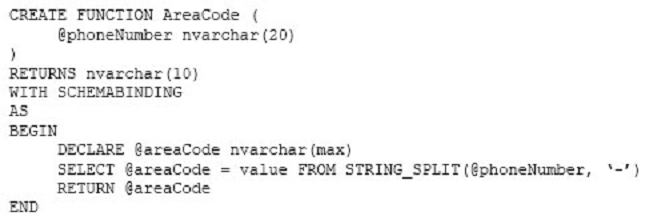
Note: This question is part of a series of questions that present the same scenario. Each question in the series contains a unique solution that might meet the stated goals. Some question sets might have more than one correct solution, while others might not have a correct solution.
After you answer a question in this section. You will NOT be able to return to it. As a result, these questions will not appear in the review screen.
You have a database that tracks orders and deliveries for customers in North America. The database contains the following tables:
Sales.Customers

Application.Cities

Sales.CustomerCategories

The company’s development team is designing a customer directory application. The application must list customers by the area code of their phone number. The area code is defined as the first three characters of the phone number.
The main page of the application will be based on an indexed view that contains the area and phone number for all customers.
You need to return the area code from the PhoneNumber field.
Solution: You run the following Transact-SQL statement:

Does the solution meet the goal?
- Yes
- No
Correct answer: B
Explanation:
We need SELECT TOP 1 @areacode =.. to ensure that only one value is returned. We need SELECT TOP 1 @areacode =.. to ensure that only one value is returned.
Question 9


Note: This question is part of a series of questions that use the same scenario. For your convenience, the scenario is repeated in each question. Each question presents a different goal and answer choices, but the text of the scenario is exactly the same in each question in this series.
You query a database that includes two tables: Project and Task. The Project table includes the following columns:

The Task table includes the following columns:

You plan to run the following query to update tasks that are not yet started:
UPDATE Task SET StartTime = GETDATE() WHERE StartTime IS NULL
You need to return the total count of tasks that are impacted by this UPDATE operation, but are not associated with a project.
What set of Transact-SQL statements should you run?
Correct answer: B
Explanation:
The WHERE clause of the third line should be WHERE ProjectID IS NULL, as we want to count the tasks that are not associated with a project. The WHERE clause of the third line should be WHERE ProjectID IS NULL, as we want to count the tasks that are not associated with a project.
Question 10
You need to create a database object that meets the following requirements:
- accepts a product identified as input
- calculates the total quantity of a specific product, including quantity on hand and quantity on order
- caches and reuses execution plan
- returns a value
- can be called from within a SELECT statement
- can be used in a JOIN clause
What should you create?
- an extended stored procedure
- a user-defined scalar function
- a user-defined stored procedure that has an OUTPUT parameter
- a temporary table that has a columnstore index
Correct answer: B
Explanation:
User-defined scalar functions are execution plans that accept parameters, perform an action such as a complex calculation, and returns the result of that action as a value. The return value can either be a single scalar value or a result set. Furthermore the execution plan is cached and reusable. User-defined scalar functions can also be called from within a SELECT statement and can be used in a JOIN clause. Incorrect Answers:A: Using extended stored procedures is not recommended as they has been deprecated. CLR Integration should be used instead of extended stored procedures.C: Stored procedures cannot be used in a SELECT statement or in a JOIN clause.D: A temporary table is a result set and not a value.References:https://www.c-sharpcorner.com/UploadFile/996353/difference-between-stored-procedure-and-user-defined-functio/ User-defined scalar functions are execution plans that accept parameters, perform an action such as a complex calculation, and returns the result of that action as a value. The return value can either be a single scalar value or a result set. Furthermore the execution plan is cached and reusable.
User-defined scalar functions can also be called from within a SELECT statement and can be used in a JOIN clause.
Incorrect Answers:
A: Using extended stored procedures is not recommended as they has been deprecated. CLR Integration should be used instead of extended stored procedures.
C: Stored procedures cannot be used in a SELECT statement or in a JOIN clause.
D: A temporary table is a result set and not a value.
References:
https://www.c-sharpcorner.com/UploadFile/996353/difference-between-stored-procedure-and-user-defined-functio/





